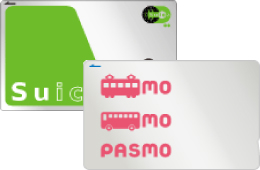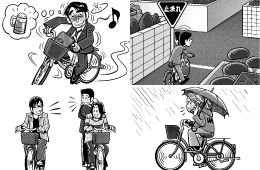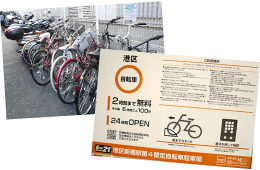Public Transportation
| Trains, subways and buses | Bicycles |
| Trains, subways and buses | Bicycles |
Minato City is an area with convenient public transportation, which includes trains, subways, a monorail, bus routes and the Community Bus service (Chii-Bus).
Fares can depend on the length of the trip or be fixed, depending on the mode of transportation. If you frequently travel the same route, you can save money by purchasing a commuter pass or a book of tickets. You can also buy a daily pass if you will be using public transportation frequently.

When using trains, subways and buses for short-distance travel, using an IC (integrated circuit) card is more convenient than buying tickets.
When you touch your IC card to the sensor on the automated gates, your fare is automatically calculated and deducted. JR East Japan sells cards called Suica, which has an IC card for fares and an e-money function. The PASMO (Greater Tokyo Area) card and other cards can also be used to pay fares on many rail lines and bus lines.
Features of PASMO and Suica
There are two types of commuter passes—one for students commuting to school and another for commuting to work.
To purchase a student commuter pass, you must present a certificate from your school certifying that you are a commuting student.
Only students attending schools approved by the rail companies can purchase a student commuter pass. Anybody can purchase a worker’s commuter pass, and there is no need to present any certificate.
Note: Inquiries can be made to JR East Japan Railway Co. in English, Chinese and Korean.
JR East Infoline
Tel. 050-2016-1603(10 a.m. to 6 p.m., except during the year-end/New Year’s holiday period)
▲To the Top of the Page
In general, bicycles should be ridden on the streets on the far left side. Riding on the sidewalks is allowed when there is a designated bicycle path, however, or when it is dangerous to ride in the street. Pedestrians have the right-of-way on sidewalks, so ride in a reasonable manner and proceed more slowly than you would on the street. In addition, when riding a bicycle you must follow the traffic laws that apply to cars and motorbikes.


When you buy a bicycle, you are required to register it (the registration fee is \500). The registration certifies that you are the owner of the bicycle, discourages bicycle theft and helps in quickly recovering a stolen bicycle. You can register your bicycle at the shop where you purchased it. If a friend or someone else gives you a bicycle, renew the registration under your name at the shop where it was purchased or get the bicycle reregistered.

If you leave your bicycle parked in the street, it will be impounded as an abandoned bicycle. It is also illegal to park bicycles in most areas around stations. There is a reclamation fee (\2,000 in Minato City) to retrieve an impounded bicycle. Make sure to park your bicycle in a bicycle parking lot (fee required).
▲To the Top of the Page